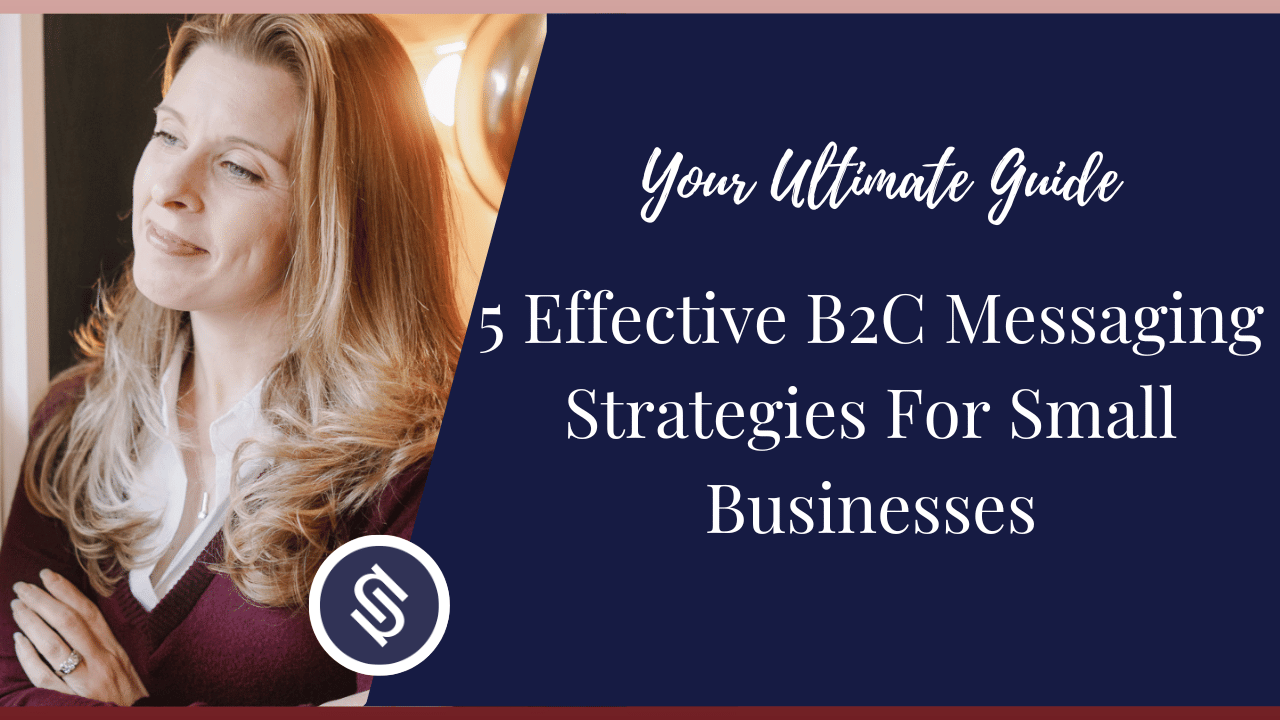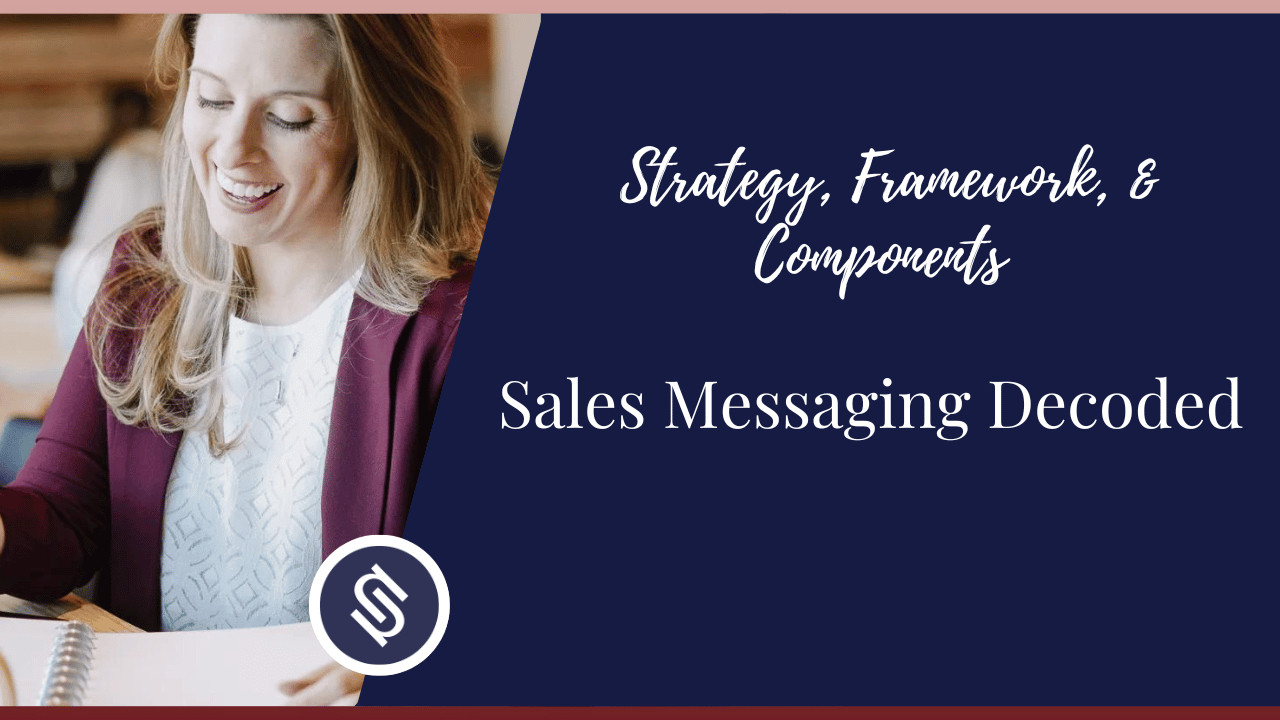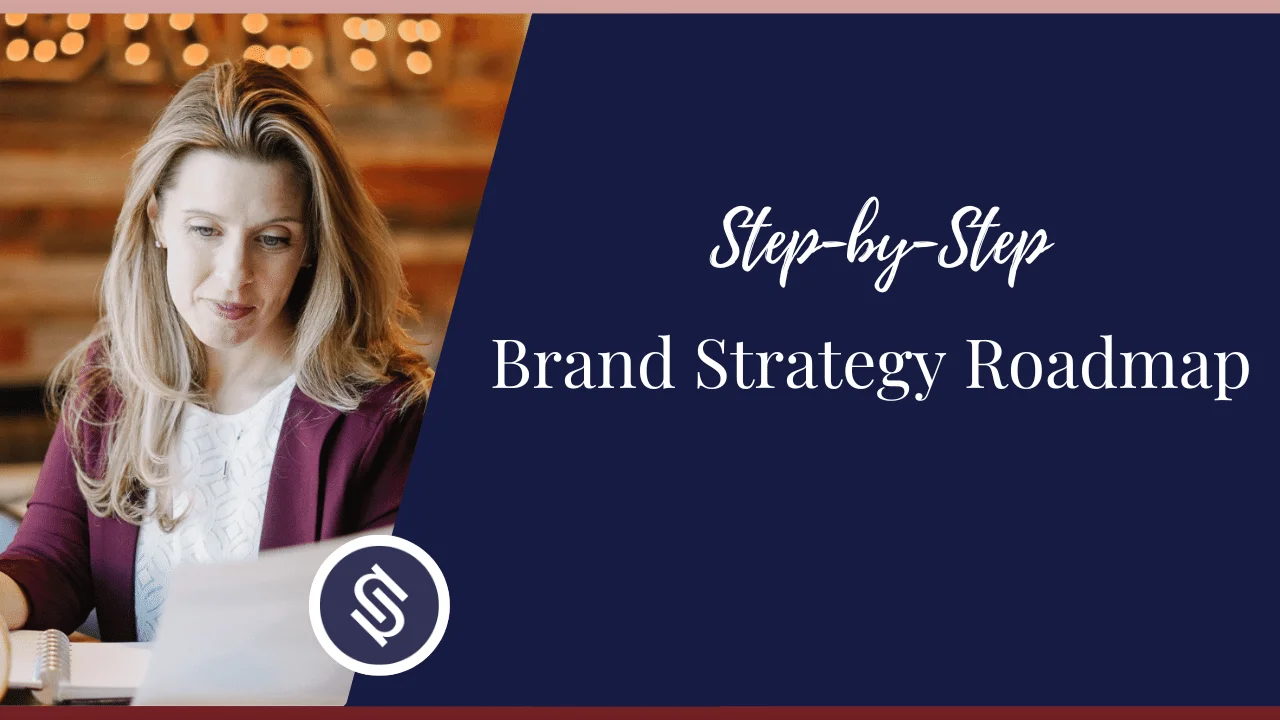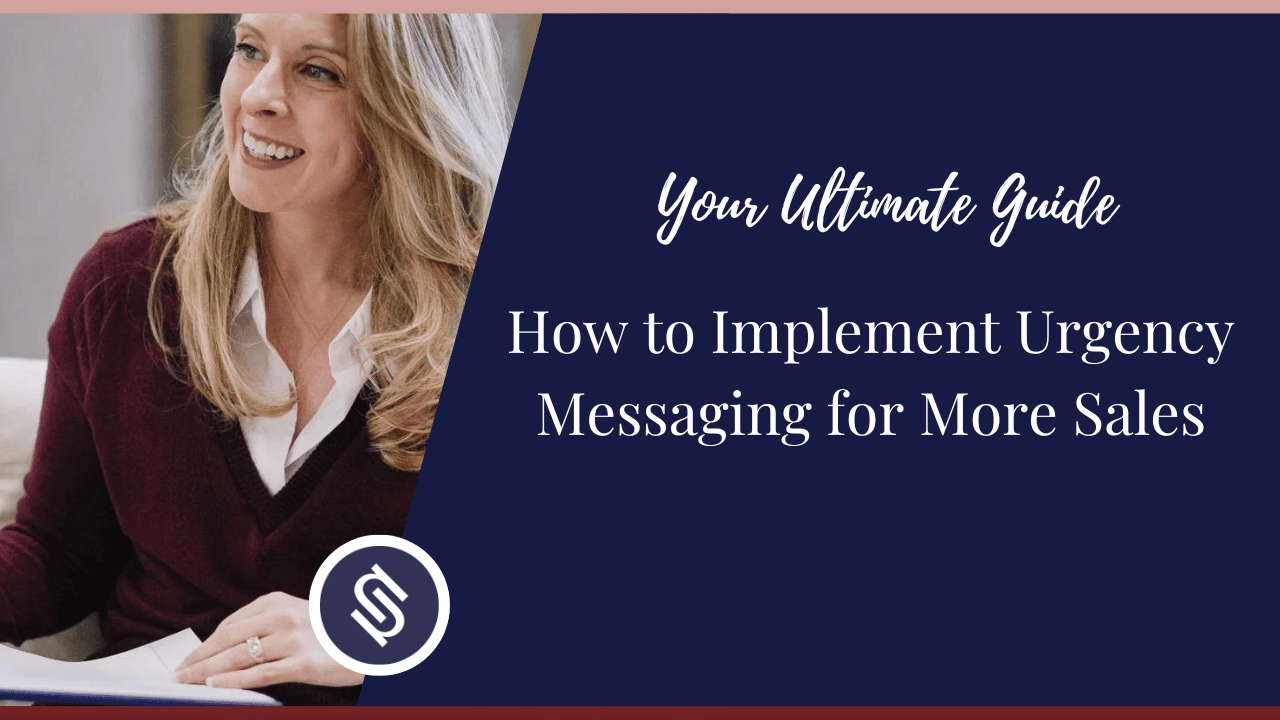Did you know that almost all enterprises in the world are small businesses? There are over 400 million SMEs globally, with around 33.2 million in the U.S. alone.
With competition this steep, how do you get your audience to remember you?
The answer is in the power of strong B2C messaging.
TL;DR – B2C Messaging Strategies
In a rush? Here are 5 B2C messaging strategies to explore for your small business:
- Delight with short-form video
- Capture your audience via email
- Partner with influencers
- Sell your message on social media
- Leverage SEO
Read the full article, where I elaborate on these strategies for establishing a strong brand position, forging deeper connections with your audience, and generating more revenue.
Need advice on your marketing strategy? Sign up for one-on-one coaching sessions with me, Nora Sudduth, to get personalized guidance for your business.

What is Business-to-Consumer Messaging?
Business-to-consumer (B2C) messaging refers to a marketing technique involving speaking directly to consumers who use your product or service.
This applies to companies that sell directly to consumers, like Spotify and Netflix. A local bakery is also an example of a B2C business.
There are also companies, like Canva and Grammarly, that serve both individual consumers and businesses. This means they can use both B2B and B2C messaging techniques.
B2B vs. B2C Messaging – What’s the Difference?
Since we mentioned B2B messaging, what does it mean, and how does it differ from B2C?
B2B or business-to-business messaging is a marketing technique used by companies that sell to or serve other businesses instead of individual consumers.
An example of a B2B company is Slack, a communications platform for businesses and remote collaborations.
Here are other essential differences between B2B and B2C messaging strategies:
| B2B Messaging | B2C Messaging | |
|---|---|---|
| Customer Relationships | Long-term and engages clients throughout a long buyer cycle | Can be more transactional and focused on sales |
| Goal | Generating leads | Encouraging quick sales |
| Strategy | Educate and highlight financial incentive | Tap into people’s emotions |
| Execution | More comprehensive and catering to various decision-makers | Simpler and more straightforward messaging |
B2C Messaging Framework
Also called a messaging architecture, a messaging framework guides how you shape messaging targeted at a specific audience.
Developing this guide ensures that key elements of your messaging are in place and stay consistent throughout your execution across all customer touchpoints and communications.
When building one, flesh out the following components:
- Target audience: Your audience directs a huge part of your messaging–as it should! The emotional appeal of your messaging comes from knowing who you’re speaking to and shaping your message according to what they resonate with.
- Value proposition: Summarizes your brand value in one concise and overarching tagline.
- Messaging pillars: Think of these as the main ideas you want your audience to understand from your messaging. They communicate key attributes and benefits of your brand that set you apart from others.
- Proof points: Lend credibility to your messaging by explaining why you are the perfect choice. These can be customer testimonials, statistics, or new technology.
Here’s a sample framework for a local vegan cafe:
| Value proposition: The best green cuisine in town We serve all-vegan farm-to-table dishes crafted from fresh seasonal produce |
||
|---|---|---|
| Messaging pillar: We offer a satisfying culinary experience that’s guilt-free and healthy | Messaging pillar: Dining with us means supporting our local farmers | Messaging pillar: Good food doesn’t have to mean expensive |
| Proof point: From main courses to desserts, every dish is made from gluten-free, plant-based ingredients | Proof point: We are the only vegan cafe in town that sources all ingredients from local farmers and producers | Proof point: We offer a farm-to-table dining experience with locally sourced ingredients, which make our products affordable |
Using this example, you can design a framework for your small business.
Better yet, work with a brand strategist who knows how to make your business more appealing to your target market.
3 B2C Communication Channels to Prioritize
Where you communicate your message is just as important as your message itself.
However, according to this HubSpot survey, marketers say the biggest challenge they face is choosing the right platforms for their messaging.
So, if you’re feeling confused about which channels to prioritize, here’s a list to make things easier for you:
1. Social Media
The most popular online activity today is social media usage, with 5 billion active users worldwide. What’s more, this number is expected to balloon to over 6 billion by 2028.
But I’m sure you’ll ask, which social media channels do I use? I know because there are lots! And more apps are being developed nearly every day.
Apps like Caffeine (which works like TikTok) and Clubhouse (a social audio app that allows users to join or start discussions) are only some of the new additions to staples like Facebook and Instagram.
Here are some considerations when choosing networks for your brand messaging:
- Align channels with your audience: Ultimately, your audience should dictate your choice of channels. Don’t let your content go unnoticed by publishing on platforms your target market doesn’t use.
- Facebook still leads the pack: Today, Facebook is the most widely used social media site, with 3 billion active users monthly. A strong presence on this site alone will increase your chances of extending your reach.
- Match your platforms with your brand identity: Go back to your brand pillars, which dictate elements like your personality and purpose, to determine the most suitable sites. For instance, if you’re a company targeting young professionals, definitely leverage LinkedIn.
2. Email
The tried-and-tested email marketing strategy remains relevant today largely because it:
- Allows you to own and grow your contact list: Your mailing list is more than a contact database. Vital information about your audience is embedded within–their location, interests, and even behavior–which you can use to tailor your message according to what elicits the most engagement.
- Inspires brand confidence and loyalty: Email content, like product updates and educational material, demonstrates your expertise and captures your audience at every stage of the marketing funnel. It also allows you to keep the communication going, which helps to reinforce your messaging.
- Is an owned channel that you can customize as you please: You have the freedom to publish as often as you need and let your creativity run free. Because it’s an owned channel, it also enables you to analyze campaign results and gain customer insights.
- Costs less than paid advertising: Unlike paid ads, where you must pay every time you put out material, you have greater financial leeway with emails. You can send as much content as needed without incurring a hefty bill.
3. Website
Your website plays a massive role in driving traffic, generating interest in your brand, and establishing authority in your niche.
Some of the best ways to maximize your website are:
- Blogs: Blogs are great for establishing expertise. But they also provide content you can repurpose for other platforms, streamlining your messaging strategy and furthering your reach.
- SEO: Deliver your content to your audience more easily by optimizing your website. This way, search engines can rank your website, increasing its visibility and driving traffic.

5 B2C Messaging Strategies for Small Businesses
Let’s proceed to strategies you can use to convey your message to your target market effectively:
1. Delight with Short-Form Video
Short-form video is huge today. In fact, one study says it’s 50% more effective at keeping people’s attention. That’s a big deal, considering there’s so much content competing for people’s attention online.
So, make it easy for people to remember your message by getting creative with “snackable” content or videos that are two minutes or shorter.
These bite-sized videos are easier to digest and encourage your audience to keep their focus on you.
2. Capture Your Audience via Email
When you hear “email,” you probably think “newsletters.”
While that’s one of the most popular and effective ways to do email marketing, there are others you can explore.
Drip campaigns (or pre-scheduled emails that catch audiences at various stages of the marketing funnel), educational emails, and promotional content are only a few types that will help you diversify what gets into your audience’s inbox.
Remember: Email marketing does work, but you don’t want to overdo it. Extremely high emailing frequency is the number one reason why people unsubscribe.
So, if you’re worried that too many people are opting out, try backing off a bit and focusing instead on quality content.

3. Partner with Influencers
Brand ambassadors and advocates amplify your message by embodying it and spreading the word.
Also, partnering with influencers builds trust.
People tend to trust what brands say about themselves less. You can overcome that challenge by having someone else to speak for or endorse you.
Tip: Choose influencers who reflect your brand identity and whose associations align with your values.
4. Sell Your Message on Social Media
According to this report, social selling is great for business, with 59% of sellers saying social media has improved their sales.
That only proves how conveying a compelling message on social media impacts your business, not only in brand awareness and reach.
So, get the word out!
Use the following tips when communicating your brand story on social media:
- Publish user-generated content: UGC works like word of mouth. It breeds trust and encourages people to engage because it’s relatable.
- Create shareable content: Get to know your audience and their context to create content that’s so good your audience can’t help but share it.
5. Leverage SEO
Use SEO techniques to bring your message closer to your audience. This means knowing your audience’s interests and needs and shaping your SEO strategy around them.
For instance, a local vegan cafe will benefit most from local SEO since its potential customers are most likely to make Google searches like “best vegan restaurant in New York.”
But don’t limit your SEO to your website. Optimize your social media posts, emails, and other content types to drive organic traffic and generate quality leads.
Your strategy might need fixing if your marketing isn’t producing enough conversions. Sign up for ConversionRX, my comprehensive marketing assessment program, which will help you spot opportunities for improvement and increase sales.

How to Craft an Effective Message that Speaks Directly to Your Users
When creating a brand message, the goal is always for it to resonate with your audience and inspire action.
But how do you do that exactly?
1. Conduct Thorough Market Research
Great messaging always begins with a deep understanding of your target audience, the market landscape, and your competition.
There are several ways to achieve that:
- Social listening: Pay attention to what people say about your brand, be that on social media, product reviews and testimonials, or online communities.
- Customer analysis: Your existing customers are a treasure trove of information. Conduct surveys, analyze sales patterns, and study past campaign results to find out what your target market wants. Also, determine pain points, aspirations, and goals your brand can help with.
- Competitor research: Demonstrate a competitive edge over similar companies by assessing what you do better than your competition. Are you cheaper or faster? Do you have an expert recommendation? Find out what makes you stand out.
2. Communicate a Compelling Brand Promise
Drawing from your value proposition, form a brand promise that encapsulates your brand’s value to your customers and how you intend to deliver.
When you know your audience’s pain points, you can align your messaging with what will get their attention.
For instance, can you provide cheaper yet healthier food choices for a market that’s increasingly health-conscious or facing health struggles?
Of course, your brand promise has to be true. Refrain from exaggerating your brand value or your product’s benefits.
3. Tap Into Your Audience’s Emotions
Did you know that most people’s buying decisions are influenced by their feelings? Your product’s benefits or features may be enticing, but what will eventually tip the scales is how your audience feels about your messaging.
What’s more, customers who have an emotional connection with a brand have a 306% higher lifetime value.
Make sure your message evokes people’s emotions by:
- Telling a story: Stories are relatable. They allow us to mirror real people and their daily struggles.
- Use storytelling techniques: Show, don’t tell. For example, don’t tell people you’re the number one trusted brand. Show them the statistics or reasons that prove it.
- Tap into emotional motivations: Shape your messaging around emotions and emotional motivations, like the desire to belong, to tell a message that makes people feel.
Every brand has a unique story to tell.
But it takes an expert to glean a brand story from your history, products, and services. Join me for a discovery call, and let me show you how we can craft a powerful message about your brand.

Frequently Asked Questions (FAQs)
I’ve answered some of the most commonly asked questions about B2C messaging here:
How Can Companies Personalize B2C Messaging for Better Engagement?
Getting to know your audience deeply to understand their pain points, problems, and goals. This will enable you to shape messaging that’s specifically for them, which is crucial because generic messaging simply doesn’t work.
How Does B2C Messaging Impact Customer Loyalty?
Delivering messages that address unique pain points at various levels of the marketing funnel–from awareness to decision-making–helps communicate that you know your audience well and care about what they need.
Keeping the communication going by providing consistent messaging also fosters trust and strengthens the bond between you and your customers.
What Are the Latest Trends in B2C Messaging Technology?
Chatbots and dynamic messaging, using customer behavior and psychology to automate responses and messages are some of the latest trends in B2C messaging technology.
How Do You Measure the Success of B2C Messaging Campaigns?
Analyzing key performance metrics, such as click-through rates, sales, and order frequency, will tell you whether you’ve met your messaging campaign objectives.
Conclusion
It’s possible to stand out in a highly saturated marketplace.
You can do this by crafting B2C messaging that communicates your unique brand story, taps into your audience’s emotions, and fosters customer loyalty.
I’ve worked with brands selling over $500M of products and services, proving compelling messaging works. Schedule a discovery call with me to learn how that can happen for your brand, too!







